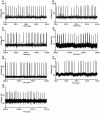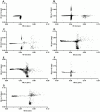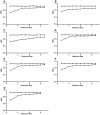Biological experimental observations of an unnoticed chaos as simulated by the Hindmarsh-Rose model
- PMID: 24339962
- PMCID: PMC3858313
- DOI: 10.1371/journal.pone.0081759
Biological experimental observations of an unnoticed chaos as simulated by the Hindmarsh-Rose model
Abstract
An unnoticed chaotic firing pattern, lying between period-1 and period-2 firing patterns, has received little attention over the past 20 years since it was first simulated in the Hindmarsh-Rose (HR) model. In the present study, the rat sciatic nerve model of chronic constriction injury (CCI) was used as an experimental neural pacemaker to investigate the transition regularities of spontaneous firing patterns. Chaotic firing lying between period-1 and period-2 firings was observed located in four bifurcation scenarios in different, isolated neural pacemakers. These bifurcation scenarios were induced by decreasing extracellular calcium concentrations. The behaviors after period-2 firing pattern in the four scenarios were period-doubling bifurcation not to chaos, period-doubling bifurcation to chaos, period-adding sequences with chaotic firings, and period-adding sequences with stochastic firings. The deterministic structure of the chaotic firing pattern was identified by the first return map of interspike intervals and a short-term prediction using nonlinear prediction. The experimental observations closely match those simulated in a two-dimensional parameter space using the HR model, providing strong evidences of the existence of chaotic firing lying between period-1 and period-2 firing patterns in the actual nervous system. The results also present relationships in the parameter space between this chaotic firing and other firing patterns, such as the chaotic firings that appear after period-2 firing pattern located within the well-known comb-shaped region, periodic firing patterns and stochastic firing patterns, as predicted by the HR model. We hope that this study can focus attention on and help to further the understanding of the unnoticed chaotic neural firing pattern.
Conflict of interest statement
Figures

 parameter space of the HR model (0.001
parameter space of the HR model (0.001 0.035, 2.3
0.035, 2.3 3.42). Colors shown in the right column are associated with the values of the largest Lyapunov exponent.
3.42). Colors shown in the right column are associated with the values of the largest Lyapunov exponent.
 and increasing
and increasing  . (A)
. (A)  ; (B)
; (B)  ; (C)
; (C)  ; (D)
; (D)  .
.

 2.53 and
2.53 and 
 0.0245. (A) Spike trains; (B) The first return map of ISI series
0.0245. (A) Spike trains; (B) The first return map of ISI series



 of chaotic firings lying between period-1 and period-2 firings observed from different neural pacemakers. Line with triangle, original data; line with circle, mean of 10 realizations of surrogate data. (A) Part 1 of the first example; (B) Part 2 of the first example; (C) Part 3 of the first example; (D) The second example; (E) The third example; (F) The fourth example; (G) The fifth example.
of chaotic firings lying between period-1 and period-2 firings observed from different neural pacemakers. Line with triangle, original data; line with circle, mean of 10 realizations of surrogate data. (A) Part 1 of the first example; (B) Part 2 of the first example; (C) Part 3 of the first example; (D) The second example; (E) The third example; (F) The fourth example; (G) The fifth example.
Similar articles
-
Dynamics of period-doubling bifurcation to chaos in the spontaneous neural firing patterns.Cogn Neurodyn. 2012 Feb;6(1):89-106. doi: 10.1007/s11571-011-9184-7. Epub 2011 Dec 7. Cogn Neurodyn. 2012. PMID: 23372622 Free PMC article.
-
Analytical predictions of stable and unstable firings to chaos in a Hindmarsh-Rose neuron system.Chaos. 2022 Nov;32(11):113113. doi: 10.1063/5.0118046. Chaos. 2022. PMID: 36456342
-
Experimental observation of transition from chaotic bursting to chaotic spiking in a neural pacemaker.Chaos. 2013 Jun;23(2):023126. doi: 10.1063/1.4810932. Chaos. 2013. PMID: 23822491
-
Is there chaos in the brain? II. Experimental evidence and related models.C R Biol. 2003 Sep;326(9):787-840. doi: 10.1016/j.crvi.2003.09.011. C R Biol. 2003. PMID: 14694754 Review.
-
Stochastic models for circadian rhythms: effect of molecular noise on periodic and chaotic behaviour.C R Biol. 2003 Feb;326(2):189-203. doi: 10.1016/s1631-0691(03)00016-7. C R Biol. 2003. PMID: 12754937 Review.
Cited by
-
Dynamic transition of neuronal firing induced by abnormal astrocytic glutamate oscillation.Sci Rep. 2016 Aug 30;6:32343. doi: 10.1038/srep32343. Sci Rep. 2016. PMID: 27573570 Free PMC article.
-
Dynamics of on-off neural firing patterns and stochastic effects near a sub-critical Hopf bifurcation.PLoS One. 2015 Apr 13;10(4):e0121028. doi: 10.1371/journal.pone.0121028. eCollection 2015. PLoS One. 2015. PMID: 25867027 Free PMC article.
-
Functional Mechanisms of Recovery after Chronic Stroke: Modeling with the Virtual Brain.eNeuro. 2016 Apr 4;3(2):ENEURO.0158-15.2016. doi: 10.1523/ENEURO.0158-15.2016. eCollection 2016 Mar-Apr. eNeuro. 2016. PMID: 27088127 Free PMC article.
-
Identification of neural firing patterns, frequency and temporal coding mechanisms in individual aortic baroreceptors.Front Comput Neurosci. 2015 Aug 26;9:108. doi: 10.3389/fncom.2015.00108. eCollection 2015. Front Comput Neurosci. 2015. PMID: 26379539 Free PMC article.
-
Hyperpolarization-Activated Current Induces Period-Doubling Cascades and Chaos in a Cold Thermoreceptor Model.Front Comput Neurosci. 2017 Mar 10;11:12. doi: 10.3389/fncom.2017.00012. eCollection 2017. Front Comput Neurosci. 2017. PMID: 28344550 Free PMC article.
References
-
- Braun HA, Wissing H, Schäfer K, Hirsch M C (1994) Oscillation and noise determine signal transduction in shark multimodal sensory cells. Nature 367: 270–273. - PubMed
-
- Yang MH, An SC, Gu HG, Liu ZQ, Ren W (2006) Understanding of physiological neural firing patterns through dynamical bifurcation machineries. NeuroReport 17: 995–999. - PubMed
-
- Hayashi H, Ishzuka S, Hirakawa K (1983) Transition to chaos via intermittency in the onchidium pacemaker neuron. Phys Lett A 98: 474–476.
-
- Aihara K, Matsumoto G, Ikegaya Y (1984) Periodic and non-periodic responses of a periodically forced hodgkin-huxley oscillator. J Theor Biol 109: 249–269. - PubMed
-
- Thomas E, William JR, Zbigniew JK, James ES, Karl EG, et al. (1994) Chaos and physiology: deterministic chaos in excitable cell assemblies. Physiol Rev 74: 1–48. - PubMed
Publication types
MeSH terms
LinkOut - more resources
Full Text Sources
Other Literature Sources
Miscellaneous

